Tracking someone in the wild is a useful skill that has many broad life applications, as it teaches us to take in the big picture first and then hone in on the details.
While we may never have to track down a fleeing criminal in the wild, a situation may arise where having the skills to track someone is a matter of life or death.
For instance, a child who wanders out into the wilderness, but doesn’t come back will require tracking to pinpoint their location.
From preparation, looking for tracks and signs, and remaining on the correct trail, tracking is both an art and science that requires patience, persistence, and practice.
Related: How To Cover Your Tracks When SHTF
Preparing To Track Someone In The Wild
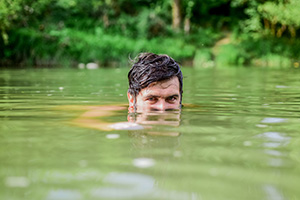 Preparing to track someone in the wild is a prerequisite that greatly increases the possibility of finding the target. First, acquire all the pertinent information regarding the target including their shoe size, what type of shoes they are wearing, weight, height, the supplies they have with them, their skill set, and their motives.
Preparing to track someone in the wild is a prerequisite that greatly increases the possibility of finding the target. First, acquire all the pertinent information regarding the target including their shoe size, what type of shoes they are wearing, weight, height, the supplies they have with them, their skill set, and their motives.
After that, learn as much about the environment where the target is likely occupying before entering it. What type of terrain does this environment consist of? Which are the impending dangers specific to this environment? What is the weather like and are any storms expected to roll through the region?
If possible, secure a map of the area, prepare all supplies for the trip, including a camera, a notepad for notes and drawings, and a compass. If given the luxury of resting and eating before heading out into the wilderness, take advantage, as this will greatly improve stamina and morale.
Where To Start Tracking Someone In The Wild?
After gearing up for the trip, start by entering the general region where a target is expected to be and scan the macro environment. Then, look for any specific tracks and signs, otherwise known as spoor, and go from there.
Ideally, start looking for spoor in terrain that is muddy or sandy, as footprints are easier to spot. Then, move to other areas, if no clues can be found initially.
Related: How To Identify Animals By Their Tracks (With Pictures)
What Spoor Are We Looking For?
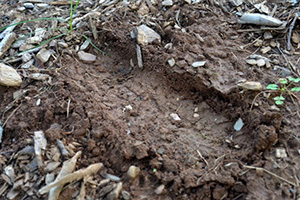 The best tracks and signs are footprints, as they can easily be followed to a target’s location. However, footprints aren’t present in all environments.
The best tracks and signs are footprints, as they can easily be followed to a target’s location. However, footprints aren’t present in all environments.
Additionally, a subject that does not want to be tracked often spoofs their footprints to push a tracker off their trail.
Other tracks and signs to look for include bent grass in one specific direction, broken branches, overturned rocks, and excrement or trash.
Additionally, fruit trees that looked like they were picked from recently, a man-made shelter, a lack of animals in the area, traces of blood, and broken spider webs all indicate that someone was recently in the area.
Broken spider webs are one of the best clues that can indicate how recently a target was in the area. If spider webs are completely broken, a target was recently in the area, often within the hour. If a spider web is partially re-built, a subject was likely in the area within the last three hours.
Tracking Footprints
Tracking footprints requires knowledge and practice.
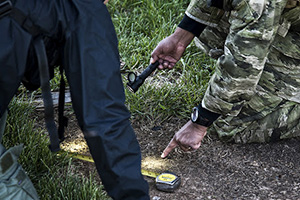
An experienced tracker looks for a specific walking pattern, soil scatter, and transfer, meaning dirt from shoes is left on another object like a rock.
All of these clues together can determine how fast a target is moving, whether or not they are carrying heavy objects, and whether or not they are trying to hide their tracks.
For instance, subjects who don’t want to be tracked may walk backward or put their shoes on backward so the tracks are leading in the opposite direction. However, an experienced tracker can tell by soil scatter and compression whether or not a walking pattern is typical.
Related: How To Cleverly Use A GPS Tracker
If tracking a hostile target, always be aware of a potential ambush and tactics designed to throw a tracker off the correct path. When tracking subjects like this, focus on the area 20 yards ahead, move slowly, and diligently look for unnatural changes in spoor, while keeping an eye out for potential traps.
If close to a target, slow down movement and in some cases, stop completely and drop to a prone position to lower the possibility of being spotted.
How To Track A Person In The Wilderness When Footprints Are Faint
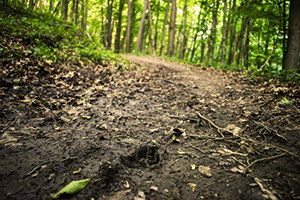 When footprints are hard to see but still noticeable, perform a strategy known as sideheading to view important details.
When footprints are hard to see but still noticeable, perform a strategy known as sideheading to view important details.
When looking at a track from the top, it is often faint, so get close to the ground and look at the track from a side view where ridges and shadows can be seen in detail.
When looking at the track from the side, focus one eye about 1 foot away and focus the other eye at a distance of about 3 feet away. This can offer more information on which way the track is headed and pick up on the next spoor.
Losing Track Of The Target
Losing track of the target is common and requires a tracker to go back to the last known spoor to re-analyze it. There are two common ways to get back on target.
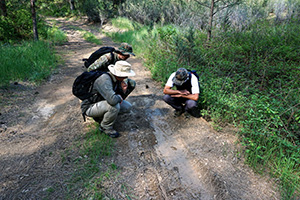
The first involves sweeping the entire area around the last track 360°, searching for the next spoor. The other, called the cross-grain method, involves walking to the right of the last track for about 50 yards and then turning left and walking for about 25 yards. At this point, turn left again and walk about 100 yards.
Then, turn right and walk 25 yards, while repeating the whole process if required. This allows the tracker to search for the next spoor in every direction and ideally pick up the next sign the target left behind.
Using Dogs To Track Someone In The Wild
Using dogs to track a target has its pros and cons. While the overall process of tracking someone with dogs is far easier, the target will also know you are near because dogs loudly make their presence known.
How To Track Someone In The Wild
Tracking someone in the wild comes down to knowledge, properly interpreting spoor, patience, persistence, and practice.
The most important factor is persistence, as a tracker will often find themselves at a loss for a continuation spoor and have to look hard for the next sign to get back on target.
You may also like:
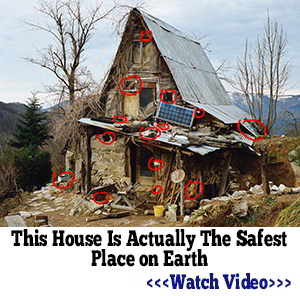 The Only Form of Communication After T-SHTF
The Only Form of Communication After T-SHTF
10 Things Cowboys Carried With Them in the Wild West to Survive (Video)
Homemade Traps for Garden Pests
How to Make Ginger Oil To Counter Prostate, Ovarian and Colon Cancer

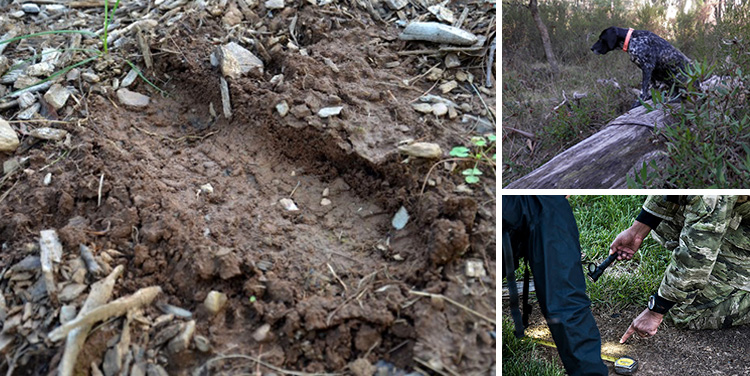













if you use a dog to track some one or something and your dog gives away your location, then that dog would never get to go tracking ever again.
Because that dog was not trained propurly.
A tracking dog should only track and not make any other sound, even moving thru the brush or over land.
That dog should be trained in hand signals also.
If you are going fox hunting, ya send in the hound dogs or raccoon hunting, those dogs will give away any ones position because they are trained that way.
A well trained tracking dog will be as quitet as the person or pray they are tracking.
A blood hound is the best tracking dog, There sence of smell is a 1000 times stronger then an human or more.
If you ever have gone bird hunting. Most dogs are called gun dogs. They are trained to not fear the gun being shot at the time they point out the bird pray.
So if you have a big mouth dog, you probably should not use that dog for tracking.
There are way to mess up the dog during the time you are being tracked.
The trick is to disrupt the dog or dogs ability to smell, by doing that, will insure that you will not be tracked, at leased not by that dog or dogs..
You can put distance between you and the dog and or the handler. That is a good way.
It’s very hard to lose a good tracking dog because you release sent that the dog uses to track you. your body is losing skin particles every second of the day your whole life. So that’s why you will need to stop the nose of the dog tracking you.
Think, you are being tracked by a human or a dog. use your ability to move away from the area as fast and as quitetly as you can.
That will be your best opportunity to get away. Putting distance between you and the tracker, being human or dog.
BUT you will always leave a trail. everything dose.
peppermint.
Red pepper throws a dog off the scent. Saw that in a Paul Newman movie.
I saw a Rambo movie. They brought the dogs to track him and he used something, white powder and the tracker said well the dogs can’t track any more.
Just can’t make my self watch them again to find out what it was???
Rambo ,1,2,3,4,5 how ever many there is know.
If you’re far enough ahead of the dog, run in a spiral working outward as far as you are able then pick a direction (not towards the dog) and run. The dog hits that spiral of scent and loses your direction since your scent is in EVERY direction.
Telling somebody (anybody) who knows very little or nothing about tracking that the best trackers are experienced doesn’t bring much value, now does it? The best hint in the article is the little ditty about sideheading. Unfortunately, time is usually “of the essence” in these situations, because typically the quarry is busy trying to put distance between you and him/her. One way to speed up the sideheading is a “flashlight on a stick” approach, where you hold a light just slightly above and across the possible track. It’s not as good, but it’s a whole lot faster and definitely helps, particularly in lower light situations. Plus, getting down on the ground and back up to your feet repeatedly saps your strength and energy, and may cause more exposure (to the elements) risk because of wetness closer to or on the ground, or insect / animal access.
The blurb talked about broken branches, bent grass and some other signs, but left out some other obvious things, like displaced leaves and other ground coverings / debris, broken mushrooms, etc. In addition, in those situations where the quarry wants to be found, there can be “breadcrumbs” of various types, ranging from markers and monuments to blazes and even signals.
In a slightly different vein, I see many videos and postings about “animal trails.” First, the only animal trails really useful to humans are deer, elk, moose, etc. trails. This is because these animals are large and at least at certain times of the year, have antlers and/or other headgear. This requires that their trails have head and shoulder room adequate for humans. Anything smaller will scurry around, through, under or over obstacles that will impede human travel. Even a bear will wend its way through and over/under obstacles that will slow a human down significantly. And you really don’t want to be caught crawling under a log when a bear comes wandering along. The notion that animals will create a gentle grade or expeditious route is pure nonsense – although their trails will sometimes lead to a valuable (to them) resource – like water, or a feeding area or even a good place for them to rest or hide. They just may not take you to where you want to go. The rest of the time – well, animals just need to keep moving around to improve their survival chances. Hunters to find prey, and prey to evade the hunters and find something to eat along the way.
My tracking. Mentor taught walking in a tight but ever widening spiral until the track was reidentified. He was Lakota.
Your best bet is to try to figure where the target is going..
Yes a lane clear of webs is an indicator.
Before game cameras, we used light string across game trails to judge activity.
In SAR, the target has got to try to help themselves, obvious clues/smoke/open area/ whistle etc.
Tracking an individual doesn’t aways apply with purely ground coverage. Take a knee and make sure to look up once in while. They may have climbed a tree. Leaving you in their wake, little pieces of spruce or pine needles or the periderm bark (outer layer.)
I know all the local animal tracks and scat, but I couldn’t track an animal, couldn’t track a human, either. I was interested in tracking years ago but Clergylady says it true, you have to have a mentor. There are some good books, I always liked the Tom Brown tracking and survival books, I never believed half his stories but his views on nature and life are always interesting. I think he’s still alive and has a school. I used to walk a short way through the woods and pastures, then start over and try to find the signs and tracks I made on the way. Hard and frustrating knowing I had recently passed and couldn’t even track myself. One thing I know about tracking, you have to be the first person out there trying to find the trail because search parties destroy or confuse most sign.
I read somewhere that the best way to lose trailing dogs is to move in figure eights now and then as you flee, crossing and recrossing your trail and circling different directions. Guess you have to be pretty fast to do that. Anybody hear about this technique? I’m old and slow, if the hounds were ever on my trail I’d have to stop and shoot them.
Back when the Illegals found the need to be more careful crossing our southern border, they would glue pieces of carpet to the bottom of their shoes. Their footprints didn’t look like shoe prints. They gave themselves away with what they thought was a deterrent against snakes. They used a lot of garlic.
I had a pretty amazing tracking experience a few years ago, though this was in a very busy food court area of the state fair, not out in nature. I noticed a young couple looking very distraught so I asked them what was wrong. They had lost their 2 year old. They gave me a brief description. I said a quick informal prayer and just started walking where I felt directed to go. I went behind the food huts, back where all the generators were. That took me to the back of the display for hot tubs. I got there just in time to see the 2 year old at the top of the stairs, leaning over a full hot tub. I called to him and he looked up, allowed me to pick him up and we went back to the food court. Back to his parents.
hello claude roger shea here just want to say i appreciate your writings on all types of subjects and life experiences merry christmas and a safe newyear to you and your family.roger
I think after such hikes, shoes can be damaged. So it’s good that there are proven cobblers that can fix even the most hopeless shoes.